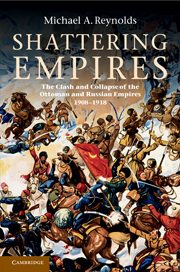Book contents
- Frontmatter
- Contents
- List of plates
- List of maps
- Note on transliteration and usage
- Acknowledgments
- List of abbreviations
- 1 Dismemberment of the Ottoman empire, 1878–1913
- 2 Eastern Anatolia and the Caucasus, 1914
- 3 Partition plans for Anatolia, 1915–1917
- 4 Borders in the Caucasus, 1918
- 5 The Turkish Republic and the Soviet Union, 1923
- Introduction
- 1 The high politics of anarchy and competition
- 2 Troubles in Anatolia: imperial insecurities and the transformation of borderland politics
- 3 Visions of vulnerability: the politics of Muslims, revolutionaries, and defectors
- 4 Out of the pan and into the fire: empires at war
- 5 Remastering Anatolia, rending nations, rending empires
- 6 Brest-Litovsk and the opening of the Caucasus
- 7 Forced to be free: the geopolitics of independence in the Transcaucasus
- 8 Racing against time
- Epilogue
- Select bibliography
- Index
- Plate section
5 - Remastering Anatolia, rending nations, rending empires
Published online by Cambridge University Press: 05 June 2012
- Frontmatter
- Contents
- List of plates
- List of maps
- Note on transliteration and usage
- Acknowledgments
- List of abbreviations
- 1 Dismemberment of the Ottoman empire, 1878–1913
- 2 Eastern Anatolia and the Caucasus, 1914
- 3 Partition plans for Anatolia, 1915–1917
- 4 Borders in the Caucasus, 1918
- 5 The Turkish Republic and the Soviet Union, 1923
- Introduction
- 1 The high politics of anarchy and competition
- 2 Troubles in Anatolia: imperial insecurities and the transformation of borderland politics
- 3 Visions of vulnerability: the politics of Muslims, revolutionaries, and defectors
- 4 Out of the pan and into the fire: empires at war
- 5 Remastering Anatolia, rending nations, rending empires
- 6 Brest-Litovsk and the opening of the Caucasus
- 7 Forced to be free: the geopolitics of independence in the Transcaucasus
- 8 Racing against time
- Epilogue
- Select bibliography
- Index
- Plate section
Summary
Even as the outcome of the world war hung in doubt, tsarist officials were thinking about the postwar challenges that Eastern Anatolia would pose to their empire's security. They had entered the war without firm plans for the region, and the advance of the Russian army only complicated matters. Some voices advocated taking formal possession of the fruits of war. The Naval Ministry coveted Trabzon and the Black Sea coast. Others, especially the energetic minister of agriculture Krivoshein, advocated colonizing Eastern Anatolia with Cossacks and Russians. Despite the appeal of annexation, up until 1916 Russia's official position on Eastern Anatolia remained that after the war the land would revert to nominal Ottoman control, albeit with enhanced Russian supervision of the region's administration. Senior tsarist officials were cool to the idea of annexing Eastern Anatolia because they regarded the Armenians as “the most difficult” of the heterogeneous populations they had to rule. The tsar's ministers believed an Armenia would only “become a burden” and a “future source of various complications,” and regretted that some circles abroad believed that the creation of an Armenia was a Russian war aim. Indeed, they feared that Russia might inadvertently bring an Armenian state into existence.
When British and French officials presented to Petrograd their proposal for partitioning the Ottoman empire, the so-called Sykes–Picot plan, the Russians initially found it unacceptable because it assigned to France territory from the Levant as far north as Diyar-ı Bekir and Lake Urmia, i.e., abutting the Russian empire.
- Type
- Chapter
- Information
- Shattering EmpiresThe Clash and Collapse of the Ottoman and Russian Empires 1908–1918, pp. 140 - 166Publisher: Cambridge University PressPrint publication year: 2011



